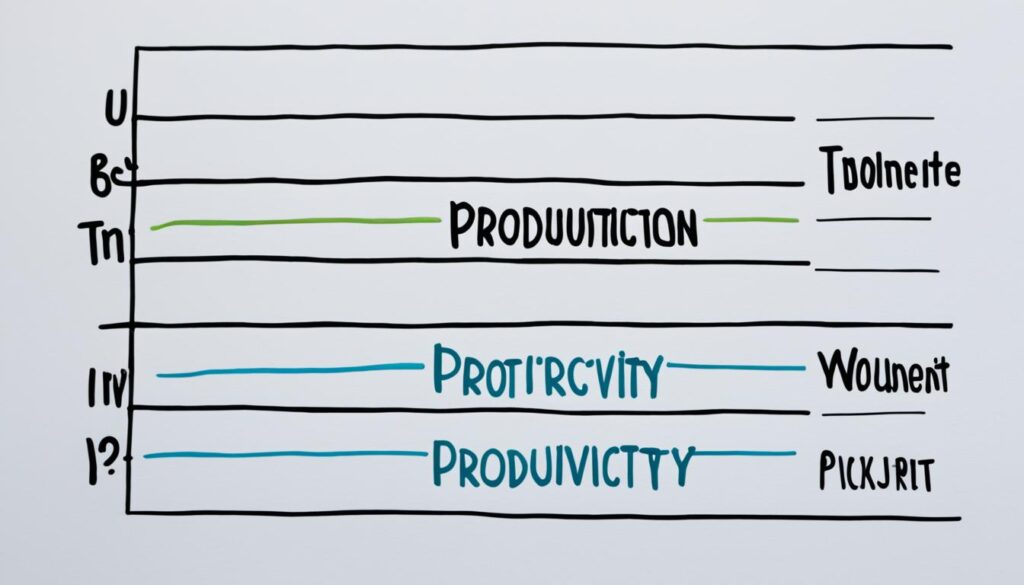Boost Your Measure of Productivity Today!

Are you struggling to keep track of your productivity metrics? Do you find it challenging to gauge your team’s efficiency and identify areas for improvement? Discover proven methods and tools to measure productivity effectively and enhance your workforce’s performance. Uncover the true measures of productivity and unlock your team’s full potential.
When it comes to productivity, the key lies in understanding how to measure and improve it. In this article, we will delve into traditional methods of productivity measurement, explore the differences between productivity and efficiency, and reveal the benefits of measuring productivity. We will also tackle the challenges organizations face in measuring productivity and provide practical tips for tracking and increasing productivity in the workplace.
So, are you ready to take control of your productivity and achieve remarkable results? Let’s dive in!
Key Takeaways:
- Discover the difference between productivity and efficiency and the significance of measuring both.
- Understand the benefits of measuring productivity and how it can drive decision-making and employee satisfaction.
- Learn about the challenges in measuring productivity accurately and how to overcome them.
- Explore various methods and tools to measure productivity and track employee performance effectively.
- Gain insights into strategies for increasing employee productivity and creating a productive work environment.
Understanding Workplace Productivity
Productivity can have different meanings for different people. However, before diving into methods to improve productivity, it’s essential to understand its definition and measurement. Traditionally, productivity has been measured based on visibility and activity, key performance indicators (KPIs), goals, and cost metrics. While these measures provide valuable insights, they often focus on inputs rather than outputs.
To truly enhance productivity, organizations need to shift their perspective and consider a more holistic approach. It’s important to define productivity as the measure of output or outcomes achieved per unit of input or resources utilized. This broader definition allows for a more comprehensive assessment that takes into account both efficiency and effectiveness.
Efficiency focuses on optimizing resource utilization, such as time, money, and energy, to accomplish tasks and goals. Effectiveness, on the other hand, evaluates whether the right tasks are being done to achieve the desired outcomes and align with organizational objectives. By combining efficiency and effectiveness, a more accurate measure of productivity emerges.
The Role of Traditional Productivity Measurement Methods
Traditional productivity measurement methods, while not encompassing the full picture, still play a crucial role. They provide valuable insights into different aspects of productivity and enable organizations to set benchmarks, track progress, and identify areas for improvement.
One common traditional method is measuring productivity based on individual or team performance against pre-set goals and KPIs. This approach ensures that employees are aligned with the organization’s objectives and work towards achieving specific targets. Another method involves comparing productivity levels across different time periods or benchmarking against industry standards to gauge overall performance.
Furthermore, organizations often use cost metrics to assess productivity. This involves analyzing the relationship between input costs, such as labor, materials, and equipment, and the corresponding output or value generated. Cost metrics provide insights into the efficiency of resource allocation and utilization.

Incorporating these traditional productivity measurement methods provides a foundation for understanding productivity levels and identifying areas for improvement. However, it’s essential to complement these approaches with a more comprehensive assessment that accounts for both efficiency and effectiveness.
Productivity vs. Efficiency: What’s the Difference?
When discussing productivity and performance, it is important to understand the differences between productivity and efficiency.
Productivity measures the quantity of work done. It focuses on how much output is generated within a given timeframe. Productivity is a measure of output relative to inputs.
Efficiency, on the other hand, emphasizes the optimal use of resources to achieve a desired outcome. It is about maximizing output while minimizing wasted resources, such as time, effort, and materials. Efficiency is a measure of the quality of output relative to the resources utilized.
While productivity and efficiency are related, they are not the same. Productivity looks at the quantity of work done, while efficiency looks at the effectiveness of resource utilization in achieving the desired outcome.
Effectiveness is another important concept to consider when discussing productivity and performance. Effectiveness measures whether the right actions are being taken to achieve the desired outcome and whether these actions align with organizational goals. It focuses on doing the right things for the desired result, ensuring that efforts are directed towards meaningful outcomes.
Understanding these differences between productivity, efficiency, and effectiveness can help organizations make informed decisions to improve their overall performance and achieve their goals.

Benefits of Measuring Productivity
Measuring productivity is crucial for organizations looking to optimize performance and achieve long-term success. By implementing robust productivity measurement practices, businesses can unlock a range of benefits that contribute to their overall growth and competitiveness.
Identifying Productivity Gaps and Areas for Improvement
Measuring productivity allows businesses to spot areas where performance falls short of expectations. By identifying productivity gaps, organizations can take targeted action to address inefficiencies, streamline processes, and optimize resource allocation. This data-driven approach enables businesses to make informed decisions that drive meaningful improvements in productivity.
Enabling Data-Driven Decision-Making
Data is the backbone of informed decision-making. Measuring productivity provides organizations with valuable insights and objective benchmarks that help guide strategic decisions. By analyzing productivity metrics, businesses can identify trends, patterns, and opportunities for optimization. This data-driven decision-making approach minimizes the risk of subjective biases and drives more effective resource allocation and investment strategies.
Boosting Employee Morale through Recognition and Appreciation
Measuring productivity not only provides valuable insights for organizational growth but also helps boost employee morale. When employees see their efforts being recognized and appreciated, it fosters a sense of achievement, satisfaction, and motivation. By acknowledging and rewarding top-performing individuals and teams, businesses can create a positive work culture that drives higher levels of engagement and productivity.
Establishing a Link between Employee Satisfaction and Productivity
Employee satisfaction plays a significant role in driving productivity. Measuring productivity allows organizations to establish a direct link between employee satisfaction levels and overall productivity. By tracking employee satisfaction metrics alongside productivity data, businesses can identify any correlations, enabling them to address factors that may be impacting employee morale and performance.
Retaining Top Talent with a Productive and Satisfying Work Environment
High employee turnover can be detrimental to organizational success. Measuring productivity helps create a work environment that fosters employee satisfaction and engagement, ultimately contributing to higher retention rates. When employees feel productive and fulfilled in their roles, they are more likely to stay with the company long-term, reducing recruitment and training costs while maintaining a cohesive and skilled workforce.
In summary, measuring productivity provides organizations with invaluable insights and benefits. By identifying productivity gaps, making data-driven decisions, boosting employee morale, establishing the link between employee satisfaction and productivity, and improving retention rates, businesses can create a culture of productivity that drives sustainable growth and success.

Challenges in Productivity Measurement
Measuring productivity accurately can be challenging, especially when it comes to assessing the impact of “soft” productivity drivers such as motivation and emotional well-being. These factors are crucial in determining overall productivity levels but are often overlooked or difficult to measure accurately. However, overlooking these drivers can have significant implications for the overall productivity and success of an organization.
One of the main challenges in measuring productivity accurately is the subjectivity associated with soft productivity drivers. Motivation, for example, can vary greatly from person to person and may be influenced by individual factors such as personal goals, work environment, and external factors. Similarly, emotional well-being is a complex concept that is challenging to quantify objectively, as it encompasses mental health, satisfaction, and overall happiness in the workplace.
Executives and non-execs may also have different perspectives on how to measure productivity, leading to a lack of consensus within the organization. While some may focus solely on tangible output and quantifiable metrics, others may recognize the importance of factors such as employee engagement and work-life balance in determining overall productivity levels.
To overcome these challenges, organizations need to take a holistic approach to productivity measurement. This involves incorporating various methods and indicators to track and measure productivity accurately. It’s essential to consider both quantitative data, such as task completion rates, revenue generated, and customer satisfaction, as well as qualitative data, including employee feedback, surveys, and performance evaluations.
| Challenges in Productivity Measurement: | Recommendations: |
|---|---|
| Subjectivity of soft productivity drivers like motivation and emotional well-being | Implement regular employee surveys to gauge satisfaction levels and identify areas for improvement. |
| Different perspectives on productivity measurement | Facilitate collaborative discussions to align on productivity metrics that encompass both tangible outputs and soft drivers. |
| Difficulty quantifying intangible factors | Develop clear objectives and key results (OKRs) that consider both quantitative and qualitative performance indicators. |
By adopting a comprehensive approach to productivity measurement, organizations can gain a better understanding of the factors that drive productivity and identify strategies to optimize these areas effectively. It’s crucial to recognize the unique challenges associated with measuring soft drivers and employ appropriate methodologies to capture and evaluate their impact on overall productivity accurately.

How to Measure Productivity
Measuring productivity is essential for organizations looking to optimize their performance and achieve success. By understanding the various ways to measure productivity and utilizing appropriate tools and metrics, you can gain valuable insights into your efficiency levels and identify areas for improvement. Let’s explore some effective methods of measuring productivity and how they can benefit your business.
Productivity Measurement Tools
Using productivity measurement tools is a practical approach to track and analyze your team’s performance. These tools provide valuable data on various aspects, such as communication and collaboration effectiveness, task completion rates, and resource allocation. By leveraging these metrics, you can identify bottlenecks in workflows, streamline processes, and enhance overall productivity.
One popular productivity measurement tool is Asana, a project management software that enables teams to track tasks, set deadlines, and collaborate seamlessly. Another powerful tool is Trello, which uses boards and cards to help teams visualize and manage their projects effectively. These tools not only monitor productivity but also promote effective communication and collaboration within teams.
Calculating Productivity
Calculating productivity involves considering multiple data points to get a holistic view of your team’s performance. Some important factors to consider include:
- Tasks Completed: Counting the number of tasks completed within a specified timeframe gives you a clear measure of output.
- Online Engagement: Monitoring online engagement metrics, such as email response time, active participation in team chats or discussion forums, and overall digital presence, can provide insights into individual and team-level productivity.
- Responsiveness: Measuring how quickly team members respond to requests or inquiries showcases their efficiency and timeliness.
- Adoption of New Technology: Tracking the adoption and utilization of new technology or tools can indicate how well your team is embracing advancements that can enhance productivity.
By carefully calculating these productivity metrics, you can identify trends, set realistic goals, and take proactive measures to improve efficiency.
Image: Productivity Measurement Tools
Measuring productivity is a continuous process that requires constant monitoring and adjustment. By utilizing productivity measurement tools and considering relevant metrics, you can gain valuable insights into your team’s performance and make data-driven decisions. This empowers you to create a more productive work environment and drive long-term success.
Increasing Employee Productivity
When it comes to improving productivity, it’s essential to identify and address the factors that can hinder employee performance. By implementing strategies that minimize distractions, provide a flexible work environment, leverage automation and AI, and offer location flexibility, organizations can create the ideal conditions for productivity to flourish.
- Minimize Distractions: Distractions can significantly impact productivity. Encourage employees to create a focused work environment by reducing noise and interruptions. Implement policies that limit unnecessary meetings and encourage the efficient use of communication tools.
- Provide a Comfortable and Flexible Work Environment: Offering flexibility in work schedules, remote working opportunities, and providing comfortable workspaces can greatly enhance employee productivity. Empowering employees to choose their work environment can foster a sense of ownership and enable them to work in a way that best suits their needs and preferences.
- Leverage Automation and AI: Embracing automation and AI technologies can streamline repetitive tasks, freeing up employees’ time and energy for more strategic and value-added work. By automating manual processes and utilizing AI-powered tools, employees can focus on tasks that require critical thinking, problem-solving, and creativity.
- Offer Location Flexibility: Granting employees the flexibility to work from different locations can contribute to increased productivity. Whether it’s working from home, a co-working space, or a different office, giving employees the freedom to choose their work environment can improve their work-life balance, reduce commuting stress, and boost overall job satisfaction.
Maximizing Employee Productivity Infographic:
| Strategies | Benefits |
|---|---|
| Minimizing distractions | – Improved focus and concentration – Enhanced task completion – Reduced stress and frustration |
| Providing a comfortable and flexible work environment | – Increased job satisfaction – Enhanced work-life balance – Improved employee retention |
| Leveraging automation and AI | – Time saved on repetitive tasks – Increased efficiency and accuracy – More time for high-value work |
| Offering location flexibility | – Reduced commuting stress – Improved work-life integration – Higher employee morale |
By adopting these strategies, organizations can empower their employees, enhance productivity levels, and drive success. Remember, a productive workforce is a key ingredient for achieving organizational goals and maintaining a competitive edge in today’s fast-paced business landscape.
Conclusion
In today’s competitive landscape, measuring and improving productivity is essential for businesses to thrive. By understanding the definition and significance of productivity, addressing challenges in measurement, and implementing effective strategies, organizations can enhance productivity levels and achieve their goals. With the right tools, techniques, and mindset, you can create a productive work environment that drives success.
Measuring productivity provides valuable insights into the efficiency and effectiveness of your workforce. It enables you to identify areas for improvement and make data-driven decisions to optimize performance. By tracking key productivity metrics, such as task completion rates, communication effectiveness, and collaboration efficiency, you can gain a comprehensive understanding of your team’s productivity and identify opportunities for growth.
Increasing productivity requires a holistic approach. It involves removing distractions, providing a flexible and comfortable work environment that empowers employees, and leveraging automation and AI technologies to streamline processes. Additionally, embracing location flexibility can enable remote work and attract top talent from anywhere in the world.
Remember, productivity is not just about working harder; it’s about working smarter. By investing in employee development, fostering a culture of innovation, and promoting work-life balance, you can create a workplace that inspires creativity and boosts employee satisfaction.
So, start measuring and improving productivity today. With a solid understanding of productivity, the right measurement tools, and a commitment to creating an environment that supports productivity, you can drive success and achieve your business goals.






